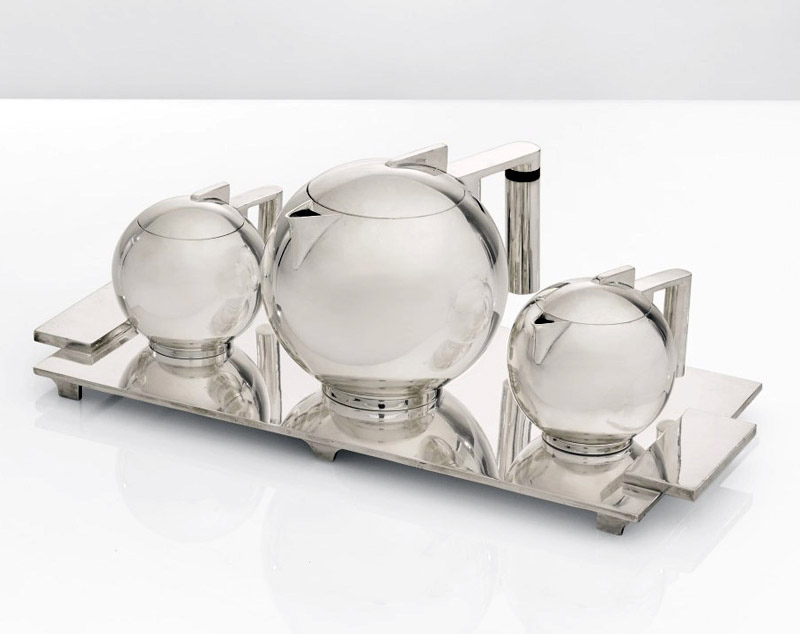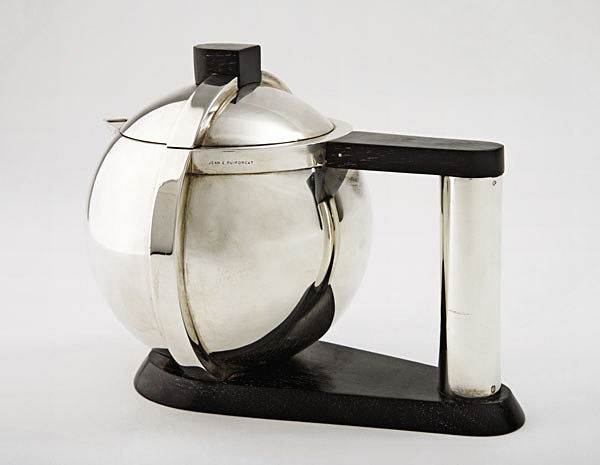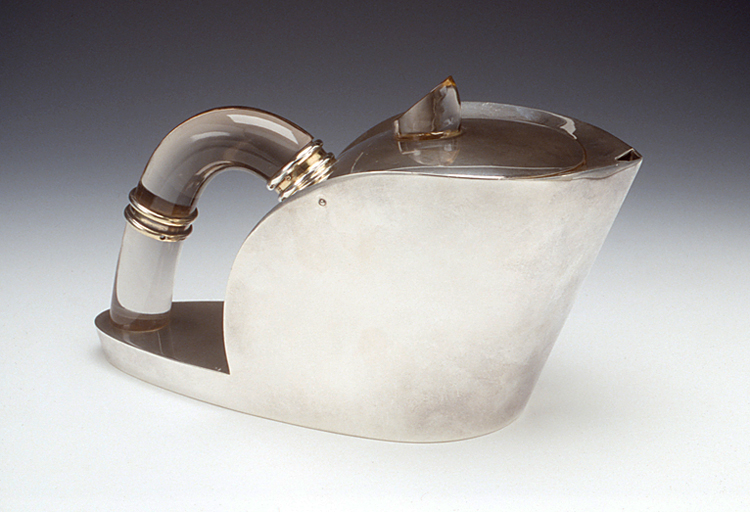“Modernism was not conceived as a style but a loose collection of ideas. It [is] a term that [covers] a range of movements in art, architecture, design, and literature, which largely rejected the styles that came before it.”[i] Between the World Wars “[this] methodology flourished in Germany and Holland, as well as in Moscow, Paris, Prague, and New York.”[ii] Typically Modernism embraced innovation, abandoned traditional approaches such as realism, experimented with form with a tendency towards abstraction, and emphasized new materials, techniques, and processes. “At the core of Modernism lay the idea that the world had to be fundamentally rethought.”[iii] Its proponents would ultimately take their “cue from technology, factories, practicality, and usefulness.”[iv]
The silversmiths Jean Puiforcat and Paul Lobel are just two of the many artists who embraced the Modernist style. Both are represented within the Kamm Collection. In this blog post we will take a closer look at these works.
JEAN EMILE PUIFORCAT (French, 1897-1945)
The “silversmith-sculptor” Jean Puiforcat initially wanted to become an architect.[v] However, after the First World War, he decided to join the family’s silversmithing business which had been founded by his great-grandfather in 1820.[vi] Puiforcat began as an apprentice learning the basic techniques and processes at their shop in the Marais district of Paris.[vii] While working on his apprenticeship he also studied sculpture at artist Louis-Aimé Lejeune’s atelier.[viii] These dual pursuits led Puiforcat to develop a personal aesthetic that eliminated “superfluous forms and ornamentation,” especially “the aberrant ones associated with the then démodé Art Nouveau movement.”[ix] Eventually, he decided that an object could not “realize its inherent beauty” unless its design was reduced to its basic function.[x]
In 1925 Puiforcat filled almost an entire pavilion at the groundbreaking International Exhibition of Modern Decorative and Industrial Arts (Exposition Internationale des Arts Décoratifs et Industriels Modernes) in Paris. These works, which all sought harmony between the object and its function, incorporated clean lines and “cleverly architectured surfaces.”[xi] Their simplicity was often offset by sumptuous materials such as exotic stones or wood. Admirers praised Puiforcat’s “mastery as a silversmith, sculptor, and colorist” while critics questioned their “mechanical beauty.”[xii] Nevertheless, following the 1925 Exposition, Puiforcat’s work rose in popularity and his name became “synonymous with Art Deco glamour” as well as luxurious highly skilled craftsmanship.[xiii]
The Kamms have eight works by Puiforcat in their collection. These objects range from tea and coffee sets to single teapot forms. As you study these designs you can see elements of Puiforcat’s evolving style. Traditional floral ornamentation present in the early 1920s eventually gave way to a study of the cube. Then, Puiforcat’s focus turned to mathematically calculated curving lines. He was always pushing himself to further develop his work. Puiforcat stated, “If there is one wish expressed in my objects, it is not that of wanting to be tied to a formula, but of hoping one day to attain what I sense, but can’t yet express…”[xiv]
Within the Kamm Collection there is a Puiforcat sterling silver teapot (c. 1937) that is particularly striking. This prow-shaped teapot was created after careful investigation of arithmetical, harmonic, and geometric principles as well as the concept known as the golden section. These studies stimulated his examination of the curve. For Puiforcat, it seems that a simple curving line could determine an entire form. A pencil drawing of the Kamm’s teapot, which is located at the Cooper Hewitt, Smithsonian Design Museum in New York, reflects this observation.
It is important to note that while Puiforcat pursued “the possibilities of form,” he also continued his “experimentation with different materials.”[xv] This teapot in the Kamm Collection is a perfect example. The knob on its lid as well as the handle are made of rock crystal.[xvi] Puiforcat also utilized vermeil, which coats the interior of the pot in addition to multiple rings on the handle.[xvii] These innovative simplified touches seem to further emphasize the form and function.[xviii] In fact, it could be argued that these new components only contributed to the “je ne sais quoi” that was always present in Puiforcat’s work.[xix]
PAUL A. LOBEL (American, born Romania, 1899 – 1983)

Over the course of his life Paul Lobel “distinguished himself as a versatile designer.”[xx] He not only illustrated magazines and books, but also created metal products, jewelry, furniture, and sculpture.[xxi] For Lobel, the 1925 International Exhibition of Modern Decorative and Industrial Arts in Paris was a true turning point. It was at that moment that he “realized that a revolution in three-dimensional design was underway.[xxii] Even once Lobel returned to the United States, those “modern metal designs he had seen in Paris haunted [him].”[xxiii]
Lobel eventually opened a studio in New York City.[xxiv] Between 1928 and 1934 his studio generated numerous works in cold rolled steel, bronze, brass, chromium, nickel, and silver. These objects ranged from decorative and sculptural accessories to some tableware for the International Silver Company. Stylistically some of these creations “were akin to the designs of Edgar Brandt, while the holloware and small chrome or polished nickel accessories were consistent with the streamlined esthetic of the time.”[xxv] In fact, in many instances Lobel’s inspiration seems to come directly from Jean Puiforcat.
The Kamm Collection has a rare, but well-known Lobel silver-plated coffee service (c. 1934) that was manufactured by Wilcox Silver Plate Company, which was a division of the International Silver Company. It contains a coffee pot, sugar pot, and creamer each engraved with the scrolling monogram SRH.[xxvi] These vessels, with their sleek spherical bodies and columnar-like handles, rest upon a crisp rectangular tray. Many historians believe this Lobel design truly “embodies the sophisticated artistic ideals of American Modernist design of the 1930s.” [xxvii] However, his vision for this coffee service was undoubtably influenced by Puiforcat’s Teapot Tête à Tête (c. 1928) which is also included in the Kamm Collection.[xxviii] Although they are similar rounded structures, Lobel’s version is more streamlined and has a lighter “subtle organic” nature.[xxix]
Lobel’s prototype for this coffee service was included in the exhibition Contemporary American Industrial Art at New York’s Metropolitan Museum of Art in 1934. The location of this prototype is unknown today and there are only four complete Wilcox services remaining. The company produced a limited number of these works. This might have been because the design was “too adventurous for American tastes” or maybe “too expensive for Depression-era pocketbooks.”[xxx] The Kamm’s service is one of the four. The Metropolitan Museum of Art and the Yale University Art Gallery in New Haven, Connecticut each have an example while the last one appears to be in a private collection.

Further Reading/Viewing:
De Bonneville, Françoise. Jean Puiforcat. Paris, France: Éditions du Rugard, 1986.
Duncan Alastair. Art Deco Complete: The Definitive Guide to the Decorative Arts of the 1920s and 1930s. New York, NY: Abrams, 2009.
House of Puiforcat website.
Johnson, J. Stewart. American Modern, 1925-1940: Design for a New Age. New York: Harry N Abrams, 2000.
Krekel-Aalberse, Annelies. Art Nouveau and Art Deco Silver. New York, NY: Harry N. Abrams, Inc., 1989.
Stern, Jewel. Modernism in American Silver: 20th Century Design. New Haven: Dallas Museum of Art and Yale University Press, 2005.
__________________________________
[i] https://www.vam.ac.uk › articles › what-was-modernism, 16 March 2022
[ii] https://www.vam.ac.uk › articles › what-was-modernism, 16 March 2022.
[iii] https://www.vam.ac.uk › articles › what-was-modernism, 16 March 2022.
[iv] https://www.vam.ac.uk › articles › what-was-modernism, 28 March 2022.
[v] Puiforcat’s business cards used the title silversmith-sculptor. https://silverhalloffame.com/bios/puiforcat-jean, 22 March 2022.
[vi] Puiforcat’s great-grandfather’s name was Félix-Armand Puiforcat. The business started as a cutlery shop. Louis-Victor (Jean’s father) was responsible for the shop’s transition to the production of luxurious goods.
[vii] Puiforcat received the title of master silversmith in 1920.
[viii] Louis-Aimé Lejeune was a French sculptor (1884-1969). Puiforcat was passionate about sculpture. However, his vocation as a silversmith was “clearly defined.” Françoise de Bonneville, Jean Puiforcat, (Paris, France: Éditions du Rugard, 1986), 16.
[ix] Alastair Duncan, Art Deco Complete: The Definitive Guide to the Decorative Arts of the 1920s and 1930s, (New York, NY: Abrams, 2009), 294.
[x] Duncan, 294.
[xi] Bonneville, 58.
[xii] Bonneville, 58. Annelies Krekel-Aalberse, Art Nouveau and Art Deco Silver, (New York, NY: Harry N. Abrams, Inc., 1989), 68.
[xiii] Like the Bauhaus designers, Puiforcat embraced the study of simple geometric forms as well as connections to the machine. However, Puiforcat’s work was not made for mass production. His designs were created by skilled craftsmen for privileged clientele.
[xiv] Bonneville, 67.
[xv] Bonneville, 70.
[xvi] After World War II this teapot design was produced with a verre optique handle instead of rock crystal. Verre optique is a type of optical glass.
[xvii] Vermeil is gilded silver, bronze, or copper.
[xviii] https://www.christies.com/en/lot/lot-2330643, 28 March 2022.
[xix] Bonneville, 70.
[xx] Toni Greenbaum, Messengers of Modernism: American Studio Jewelry 1940-1960, (Paris: Montreal Museum of Decorative Arts and Flammarion, 1996), 96.
[xxi] Lobel opened one of the first jewelry studios in New York’s Greenwich Village in 1944.
[xxii] https://www.ganoksin.com/article/paul-lobel-innovator-mid-century-design/, 18 March 2022.
[xxiii] Greenbaum, 96.
[xxiv] The studio/workshop was opened with a partner. His name was Leo J. Uris. There is very little information available about Uris’ background.
[xxv] www.ganoksin.com/article/paul-lobel-innovator-mid-century-design/, 30 March 2022.
[xxvi] SRH stands for Sarah Roe Hartman. It was presented to her when she married in 1935.
[xxvii] https://www.sothebys.com/en/auctions/ecatalogue/2014/important-20th-c-design-n09155/lot.77.html, 29 March 2022.
[xxviii] This teapot is referred to as a tête à tête because it was from a service for two. Puiforcat’s website currently describes this as a coffee or teapot Sphère.
[xxix] Jewel Stern, Modernism in American Silver: 20th Century Design, (New Haven: Dallas Museum of Art and Yale University Press, 2005), 117.
[xxx] https://artgallery.yale.edu/collections/objects/129437, 30 March 2022.
Allie Farlowe is a metalsmith, jeweler, and independent arts writer. Her previous professional experience includes museum work in curatorial and registration departments.

